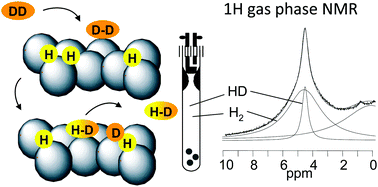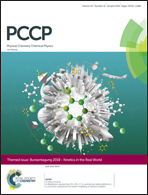Gas phase 1H NMR studies and kinetic modeling of dihydrogen isotope equilibration catalyzed by Ru-nanoparticles under normal conditions: dissociative vs. associative exchange†
Abstract
The equilibration of H2, HD and D2 between the gas phase and surface hydrides of solid organic-ligand-stabilized Ru metal nanoparticles has been studied by gas phase 1H NMR spectroscopy using closed NMR tubes as batch reactors at room temperature and 800 mbar. When two different nanoparticle systems, Ru/PVP (PVP ≡ polyvinylpyrrolidone) and Ru/HDA (HDA ≡ hexadecylamine) were exposed to D2 gas, only the release of HD from the hydride containing surface could be detected in the initial stages of the reaction, but no H2. In the case of Ru/HDA also the reverse experiment was performed where surface deuterated nanoparticles were exposed to H2. In that case, the conversion of H2 into gaseous HD was detected. In order to analyze the experimental kinetic and spectroscopic data, we explored two different mechanisms taking into account potential kinetic and equilibrium H/D isotope effects. Firstly, we explored the dissociative exchange mechanism consisting of dissociative adsorption of dihydrogen, fast hydride surface diffusion and associative desorption of dihydrogen. It is shown that if D2 is the reaction partner, only H2 will be released in the beginning of the reaction, and HD only in later reaction stages. The second mechanism, dubbed here associative exchange consists of the binding of dihydrogen to Ru surface atoms, followed by a H-transfer to or by H-exchange with an adjacent hydride site, and finally of the associative desorption of dihydrogen. In that case, in the exchange with D2, only HD will be released in the beginning of the reaction. Our experimental results are not compatible with the dissociative exchange but can be explained in terms of the associative exchange. Whereas the former will dominate at low temperatures and pressures, the latter will prevail around room temperature and normal pressures where transition metal nanoparticles are generally used as reaction catalysts.

- This article is part of the themed collection: Bunsentagung 2018: Kinetics in the Real World


 Please wait while we load your content...
Please wait while we load your content...